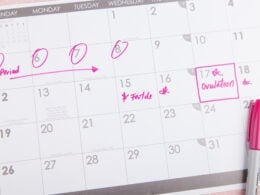For a long time, my menstrual cycle was essentially a battle fought with tampons and Midol. I didn’t retain much from my 8th grade science class. I memorized the facts about hormones, pituitary glands, follicles and ovules, but they remained obscure concepts for me. Then I forgot it all the day after the test. We probably went over it again in high school … no memory of it. After that no one ever said another word about it: not a girlfriend, not my mother, not even my Ob/Gyn.
It was only many years after my first period that I really began to understand what went on every month in my lower abdomen. And began to realize how amazing it is.
Before we start, I want to clean up a bit our way of talking about this stuff. So how about if today we talked about fertility instead of feminine hygiene (what a lame term, seriously! The word hygiene implies that it’s something dirty)? How about if we talked about ovulation instead of menstruation? At first it may not seem to make much difference, but when you look a little closer …. you will see what I mean. Because the menstrual cycle is not a story of tampons and pads; it is the wonderful story of an egg.
Once upon a time…
… an egg? It’s no small matter! For one thing, it is the biggest cell of the human body. It measures about 150 micrometers, that is to say 15% of a millimeter (= 30 times larger than the head of a sperm cell). It is visible to the naked eye: it’s about the size of the hole a needle would make in a sheet of paper. But in addition it is the most powerful cell: it contains half of all it takes to make a human being. We also call this egg the ovum or ovule.
You know how we talk about THE Super Bowl? THE New York Times #1 best seller? THE Hit of the Summer? Well, think of this as THE Ovule story of the month. The drama of fertility takes place in four suspenseful episodes, each in its own setting.
Episode 1: in the ovary
Picture an ovary, the size of an almond, carefully held by a membrane close to the uterus. At the beginning of the woman’s life, it contains 500,000 carefully packed eggs, each enclosed in a protective envelope called the follicle. They have been waiting there since her birth. Each month from adolescence to menopause, about 20 of these follicles are pre-selected and prepared. Among them, only one will be chosen to enlarge and then release the ovule it contains. During the first phase of the cycle, following your period, this follicle grows: that’s why it is called the follicular phase. Once the maturation of the follicle is complete, the brain sends a messenger called the LH hormone to command the release of the egg. At last ready to go, the tiny but determined ovule escapes its cozy bedroom to go to find … love ♥♥.
Episode 2: in the fallopian tube
This episode is when the first kiss happens, or not. It is very short: less than 24 hours! When the ovule is released from the ovary, it hangs out in the fallopian tube where it waits for Prince Charming, that is, if a fleet of sperm cells show up, and if the right guy is among them, fertilization happens; if not, the ovule disappears. In either case, what happens then is a well kept secret for several days. Questions like: “Well, did he kiss her or not ??” remain unanswered. No other part of the body is aware of what has happened (this is why pregnancy tests don’t work right away).
Episode 3: in the uterus
The suspense continues during this episode, which can have two very different endings. It will take about 14 days to know if the egg has been fertilized or not. Was there a first kiss? If yes, there is a good chance that the fertilized egg will try to nest somewhere… but before it settles and implants in the uterus, the loving couple is enjoying a secret honeymoon of six to nine days.
Meanwhile, the follicle that contained the ovule continues to play a big role in this story. Emptied of the egg, it now turns into the “corpus luteum,” or “yellow body.” It releases its own tiny workers, progesterone hormones, who help the uterus strengthen its cushy lining (the endometrium) and prepare itself for the possible welcoming of a fertilized egg. This action, also called the luteal phase, happens whether or not the first kiss between the egg and Prince Charming took place. The suspense is still at its peak.
Episode 4: in the vagina
Now comes the resolution, the denouement of this drama. If there was fertilization and implantation of the egg in the uterus, most of the action remains in the uterus: it is known as pregnancy. In this case, Episode 4 is pretty much cancelled: see you in nine months. But otherwise, the story continues and the ending takes place in the vagina. Our body realizes that the ovum has not been fertilized and that the uterus lining has thickened for nothing: the progesterone hormones take their leave for a well-deserved rest: this hormonal fall triggers the period. Watch it evacuate the thick uterus lining that was prepared for the fertilized egg that never showed up. Now rendered useless, it is removed so that it can be built afresh next time. Episode 4, end of the season. But do not worry, another episode is already getting underway! The series will only end at menopause.
Don’t you think we appreciate our periods more fully when we realize how it all works? Instead of dreading it as a monthly tribulation, it becomes the magnificent signal that we have done what’s necessary to keep us ready to give life. Most of the time fertilization doesn’t happen, but the woman’s body, no sore loser, doesn’t get discouraged. It starts preparing another egg as soon as it becomes clear that this time was not the right time. What persistence! It’s inspiring for our daily life.
Yes, guys, we pour out our blood each month to—quite simply—save mankind. I’d say we deserve a medal.
Tiare
(translated and edited by Anna and Gerard Migeon with permission)












